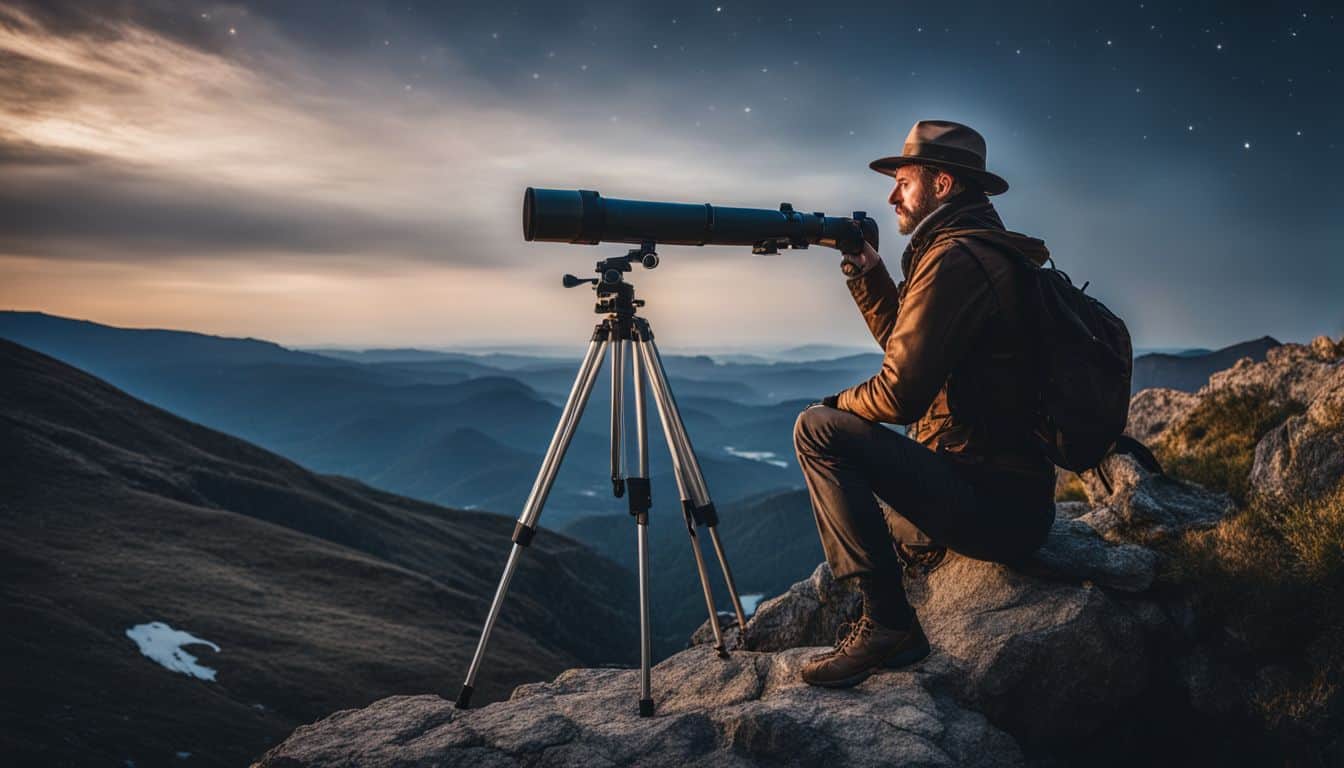As an adventurer at heart who constantly finds themselves enthralled by the boundless beauty of nature, I understand how easy it is to become disoriented. But don’t let that hinder your spirit of adventure! As someone who has faced a similar dilemma, allow me to share my comprehensive guide on navigating using only stars—just like intrepid explorers did centuries ago.
Don’t allow uncertainties about direction dampen your wanderlust; instead, take a plunge into this fascinating world of star navigation and turn it into your secret ace in the hole.
Key Takeaways
- Celestial navigation is an ancient technique that uses stars to determine one’s position on Earth.
- By learning how to locate key stars like the North Star and understanding basic concepts like latitude and longitude, you can navigate using stars effectively.
- Tracking a star’s position and utilizing a compass are essential skills for successful celestial navigation.
- Learning constellations and accurately determining the time are important tips for navigating with the stars.
What is Celestial Navigation?
Celestial navigation is the ancient art of using celestial bodies, such as stars, to determine one’s position on Earth. It has a long history and involves angular measurements to calculate latitude and longitude for practical navigation purposes.
Definition
Celestial navigation is a really old way of finding your spot on the sea. You use stars, the moon, sun and where they are in the sky compared to the horizon. It’s also named taking “sights”.
For this, you need special tools like sextants to measure how far apart these things are from each other and from the horizon. This helps you figure out exactly where you are.
History
Stars have always been our guides in the night sky. People in old times turned to them for help finding their way, even on open seas. Ancient stories speak of using stars for directions too.
The Polynesians, expert sailors, knew these secrets well. They read the stars and used this knowledge to cross big oceans in canoes. Before we had tools like maps and GPS, mariners also looked up at the sun and stars.
They could tell where they were and what time it was just by looking up! This way of using celestial bodies has shaped a long tale of sea travel history.
Angular measurement
In celestial navigation, we use a process called angular measurement. This is how we measure the angle of a star or other sky body from the horizon. We do this with tools like a sextant or bubble octant.
With these tools, we mark down the measurements using Greenwich Civil Time. The height of something in the sky helps us tell where we are. For example, by seeing how high the North Star is over the sea level, we can tell our latitude position.
This way, no matter where you are at sea or on land, you can always find your way!
Practical navigation
As a survival enthusiast, I know that practical navigation is crucial in the wilderness. One method that can be incredibly helpful is celestial navigation. This type of navigation uses stars and planets as reference points to determine your position.
By using tools like sextants and star charts, you can measure angles between celestial bodies and the horizon to find your way. It’s especially useful in remote areas or during emergencies when other navigation systems may not be available.
Celestial navigation allows you to rely on the stars for guidance, helping you navigate accurately and safely.
Basics of Using Stars for Navigation

It’s a technique that has been used by early navigators when traveling on the open ocean.
To navigate using stars, you need to familiarize yourself with star patterns and learn how to identify specific stars like Polaris (the North Star) or the Big Dipper. These stars can help you find your bearings and determine which direction you are facing.
Navigating by stars also requires understanding basic concepts such as latitude, which is your distance north or south of the equator, and longitude, which is your distance east or west from a reference point.
By knowing these measurements, you can accurately determine your position.
While celestial navigation may seem complex at first, it becomes easier with practice and experience. With time, you’ll be able to confidently navigate through unfamiliar terrain using only the light from the night sky.
So grab a star chart and start exploring this ancient art of finding your way through the heavens!
Finding North in the Northern Hemisphere
To find North in the Northern Hemisphere, locate the North Star, identify your latitude, and then determine which direction is south.
Locating the North Star
To find the North Star, also known as Polaris, look for the Big Dipper constellation. The two stars on the end of the Dipper’s “cup” will point you in the direction of Polaris. It’s important to note that while Polaris is not directly on Earth’s north celestial pole, it is very close to it.
This means that in the northern hemisphere, the North Star is always above the horizon and can be easily located. By finding and using the North Star for navigation, you can determine which way is north.
Identifying your latitude
To navigate using stars, it is important to know how to identify your latitude. One way to do this is by finding the North Star, also known as Polaris. The North Star will be the same angle above the horizon as your latitude.
To measure this angle accurately, you can use a tool called a kamal. This traditional method of determining latitude involves estimating the angle between Polaris and the horizon. By mastering these skills, you will be able to navigate using stars effectively and confidently in the northern hemisphere.
Finding south
To find south in the Northern Hemisphere, I use the North Star. It’s a really handy tool! First, I locate the North Star in the night sky. Then, I know that if I face towards it, I am facing north.
So to find south, all I have to do is turn around and head in the opposite direction! It’s as simple as that. No need for complicated compasses or gadgets – just a star and my own sense of direction.
This skill comes in super handy when you’re out in nature and don’t have access to technology or GPS. Knowing how to navigate using stars is an important survival skill that can help keep you on track no matter where you are.
Finding Direction in the Southern Hemisphere
In the southern hemisphere, locating the South Star is key to finding your direction. By identifying your latitude and determining east or west based on other celestial bodies, you can navigate confidently even in unfamiliar waters.
Locating the South Star
In the Southern Hemisphere, finding your direction can be a bit tricky because there isn’t a bright star pointing south like there is in the Northern Hemisphere with the North Star.
Instead, we use a constellation called the Southern Cross to find due south. The Southern Cross is made up of four stars that form a cross shape in the sky. Look for this constellation and you’ll know you’re facing south.
Another helpful star is Eta¹ Doradus, which is closest to the south pole. It helps us figure out our orientation in the Southern Hemisphere. Just remember, when using stars for navigation, look at ones that arc through the sky at an angle until they are about 30-35 degrees off the horizon to determine your direction.
Finding your latitude
To find your latitude in the Northern Hemisphere, you can use the North Star, also known as Polaris. This star is located almost directly above the Earth’s North Pole. By measuring its elevation above the horizon, you can determine your approximate latitude on Earth.
The higher Polaris appears in the sky, the closer you are to the North Pole. This information is crucial for celestial navigation because it helps you find direction when navigating in the Southern Hemisphere using stars.
So remember, by finding your latitude with Polaris, you’ll be able to navigate more effectively no matter where you are on this planet!
Determining east or west
To determine east or west in the Southern Hemisphere using stars, you need to locate the South Star, also known as Sigma Octantis. Similar to how the North Star helps identify true north in the Northern Hemisphere, the South Star can help you find true south.
By locating this celestial body, you can then determine your latitude and subsequently figure out which direction is east or west. Remember that stars always travel from east to west in a line across the sky.
So now, armed with this knowledge, you can confidently navigate your way through unfamiliar territory using celestial navigation techniques.

Following a Star’s Position Anywhere
Tracking a star’s position is essential for celestial navigation. By understanding how to track a star’s movement and utilizing a compass, you can navigate your way through any location with ease.
Discover the secrets behind this powerful technique and unlock your ability to dominate in navigation. Read more on my blog!
Tracking a star’s position
To navigate using the stars, tracking a star’s position is crucial. By observing the movement of a specific star over time, we can determine our direction and stay on course. Whether you’re lost in the wilderness or out at sea, following a star’s position anywhere can lead you to your desired destination.
It’s an age-old technique that has been used by early navigators to successfully traverse vast oceans. One particularly helpful star for navigation is the North Star, also known as Polaris, because it remains fixed in the sky while other stars move around it.
So remember, keeping track of a star’s position is key when using celestial navigation for survival or exploration purposes.
Utilizing a compass
To navigate using a compass, simply hold it flat and level in your hand. The compass has a magnetic needle that always points towards the Earth’s magnetic field. When you turn, the needle stays still while the numbers on the dial move.
This way, you can easily determine which direction you are facing. It’s important to note that using a compass is quicker and easier than relying on stars for navigation. So if you’re lost or need to find your way quickly, a compass is your best bet.
Plus, they have been used by sailors and explorers for centuries, so they are tried and true tools for finding direction and determining our position in relation to north-south-east-west coordinates on maps or charts.
Tips for Navigating with the Stars
Learn the constellations to easily identify key stars in the night sky. Determine the time accurately using a reliable watch or celestial navigation tools, and choose the right material for your navigation journey.
Ready to discover more tips? Continue reading to master the art of navigating with the stars.
Learn the constellations
To navigate using the stars, it’s helpful to learn about constellations. A constellation is a group of stars that form a picture when lines are drawn between them. By connecting the stars in a particular pattern, you can identify different constellations in the night sky.
There are 38 constellations you should know if you want to spot all 58 stars used for navigation. Learning these constellations will help you navigate more easily and recognize deep-sky wonders like galaxies and nebulae.
So take some time to study the stars and uncover the mysteries of the universe!
Determine the time
To navigate with the stars, it’s important to determine the time accurately. Knowing the time will help you locate specific stars and constellations in the sky. One way to determine the time is by using an astronomical instrument called a sextant.
A sextant measures the angle between celestial objects, such as stars and the horizon. By measuring this angle and consulting star charts or tables, you can calculate the exact time based on celestial positions.
Another method is to use a watch set to Coordinated Universal Time (UTC), which is based on atomic clocks and provides highly accurate time reference anywhere in the world. With these methods, you can ensure that your navigation with stars remains precise and effective.
Pick the right material
To navigate using stars, it’s important to pick the right material. You’ll need star charts or maps that show the constellations and their positions in the night sky. These charts can help you identify specific stars for navigation.
Additionally, having a compass can be helpful for determining direction based on the position of certain stars. So when preparing for celestial navigation, make sure to have these essential materials on hand.
Using Celestial Navigation to Explore the World
Celestial navigation has played a vital role in the exploration of the world, with cultures like the Polynesians, Marquesans, and Pacific Islanders using stars as their guides to navigate vast oceans and reach distant lands.
Polynesians
Polynesians were skilled navigators who used celestial navigation techniques to explore the world. They relied on the stars, elements, and currents to navigate across vast oceans. The Polynesian navigators would memorize star positions and use their observations to guide them on their wayfinding journeys.
One traditional technique they used was the Hawaiian star compass, which helped them determine their direction by mapping out different stars in relation to specific islands. Their navigation system was based on a deep understanding of star patterns and the behavior of the ocean.
Through their knowledge and skill, Polynesians were able to successfully explore and settle many remote islands in the Pacific region.
Marquesans
The Marquesans were skilled navigators who used celestial navigation to explore the world. They relied on stars, elements, and ocean currents to guide them on their journeys across the vast Pacific Ocean.
Using tools such as the Hawaiian star compass and sun compasses, they were able to navigate with precision. Their knowledge of interpreting winds and waves also helped them navigate effectively.
The Marquesans’ expertise in using stars and other celestial bodies for navigation is a testament to their ancient wisdom and ingenuity.
Pacific Islanders
I find it fascinating how Pacific Islanders were able to explore the world using celestial navigation techniques. They were skilled navigators who relied on the stars, elements, and currents to guide their way.
Through wayfinding techniques like navigation by the stars and observations of birds, ocean swells, and wind patterns, they were able to discover new islands. Traditional Polynesian navigators used a star compass mainly for positioning themselves based on the stars’ positions in the sky.
It’s incredible how they could observe clouds and other natural elements as well to determine their location.
Detailed Guide on How To Navigate with the Stars
I want to share a detailed guide on how to navigate using the stars for survival. Here are nine ways you can dominate your navigation skills with the stars:
- Learn about celestial navigation: Take an online course, like “The Beginner’s Guide to Natural Navigation,” that teaches you how to use celestial bodies for navigation.
- Understand angular measurement: Celestial navigation involves taking “sights” or timed angular measurements between celestial bodies.
- Familiarize yourself with specific stars and constellations: Learn about different stars and constellations in the night sky, as they can help you find your way.
- Locate the North Star (Polaris) in the Northern Hemisphere: The North Star is always aligned with Earth’s axis, making it a great reference point for finding north.
- Identify your latitude using the North Star: By measuring the angle between the horizon and the North Star, you can determine your latitude.
- Find south by using the North Star: If you’re in the Northern Hemisphere, facing Polaris means you’re also facing north, so turning 180 degrees will point you south.
- Locate the South Star (Sigma Octantis) in the Southern Hemisphere: There is no bright star directly above our South Pole like Polaris, but Sigma Octantis can serve as a useful reference point.
- Determine your latitude in the Southern Hemisphere using Sigma Octantis: Just like with Polaris, measuring the angle between Sigma Octantis and the horizon can tell you your latitude in the Southern Hemisphere.
- Determine east or west by tracking a star’s position: By observing how a star moves over time, you can determine whether you’re facing east or west.
Benefits of Celestial Navigation
Improved accuracy, low cost, and quick position fixing make celestial navigation a valuable tool for navigating the world’s oceans. Discover how using stars for navigation can transform your travel experience.
Improved accuracy
When using celestial navigation, the accuracy of your navigation can be greatly improved. With the addition of crosslink measurements and modern navigation tools, you can achieve sub-arcsecond angular precision.
This means that your calculations will be incredibly precise, helping you navigate with greater accuracy. Celestial navigation offers improved accuracy and availability through the use of new technology, making it a reliable method for finding your way in survival situations or when exploring the great outdoors.
Low cost
Celestial navigation offers an affordable way to navigate without expensive technology or equipment. It’s a cost-effective option that allows sailors to determine their position using the stars, making it a budget-friendly choice for anyone who loves survival adventures.
By using celestial navigation, you can save money while still enjoying the thrill of navigating the world. It’s a thrifty and economical way to explore your surroundings and make the most of your resources.
So why spend more when you can enjoy the benefits of celestial navigation at a fraction of the price?.
Quick position fixing
Quick position fixing is a crucial aspect of celestial navigation. By observing the positions of stars and other celestial bodies in the sky, we can determine our exact location on the open ocean.
This method allows us to find our way without relying on GPS or other electronic devices. With just a sextant, navigational charts, and some basic calculations, we can quickly fix our position and stay on course.
It’s a reliable technique that has been used for centuries by sailors and explorers all over the world. So even if you’re out in the middle of nowhere, navigating with the stars can help you find your way back home.
Conclusion on Using stars for navigation
In conclusion, mastering the art of using stars for navigation can give you a powerful advantage in finding your way. By learning how to locate the North Star, identifying constellations, and understanding celestial navigation tools, you can confidently navigate the open ocean or explore new territories.
So why not harness the ancient wisdom of our ancestors and dominate your next adventure with star-based navigation? It’s a skill that will truly set you apart.
FAQs on Using stars for navigation
1. Can I use stars for navigation even without a compass or GPS?
Yes, you can use stars for navigation as long as you have clear visibility of the night sky and some knowledge about star patterns.
2. How do I identify constellations in the night sky?
To identify constellations, look for groups of stars that form recognizable shapes or patterns, such as Orion’s belt or the Big Dipper.
3. Are there any specific stars that are commonly used for navigation?
Polaris, also known as the North Star, is a commonly used navigational star in the Northern Hemisphere due to its fixed position relative to Earth’s axis.
4. What other celestial objects can be used for navigation besides stars?
In addition to stars, other celestial objects like the moon and planets can provide valuable information for navigation if their positions are known.
5. Is it necessary to have extensive knowledge of astronomy to navigate using stars?
No, extensive knowledge of astronomy is not required to navigate using stars. Basic understanding of star patterns and their movements across the sky is sufficient for basic navigational purposes.





Leave a Reply